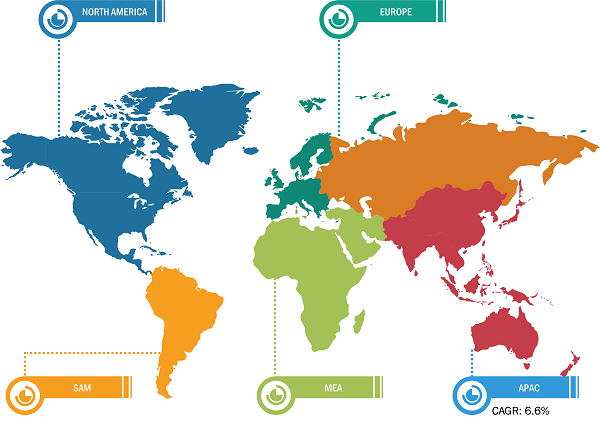
Reclamation Sand Market
In 2022, Asia Pacific held the largest share of the global reclamation sand market and is expected to record the highest CAGR in the global reclamation sand market during the forecast period. The demand for reclamation sand is directly proportional to the region’s expansion of the foundry industry.
Depletion of Natural Sand Resources
Natural sand is considered a finite resource, and the extraction of sand from rivers and beaches has resulted in severe environmental damage. Governments and environmental agencies have imposed strict regulations on the extraction of natural sand, leading to a shortage of supply. As a result, the demand for reclamation sand has increased significantly. Reclamation sand is made from recycled materials such as crushed concrete, glass, and ceramics, which reduces the need for natural sand extraction. The use of reclamation sand not only helps to conserve natural resources but also reduces carbon emissions and waste disposal. The growing awareness of sustainable development practices has also contributed to the popularity of reclamation sand. Governments and construction companies are increasingly adopting sustainable practices to mitigate the impact of construction activities on the environment. Approximately 50 billion tons of sand is extracted annually for extraction and industrial activities, and the rate of replenishment of this resource is significantly slow; hence, reclamation sand is used as a substitute for natural sand. In addition to environmental benefits, reclamation sand also offers economic advantages. It is often cheaper than natural sand, which makes it an attractive option for construction enterprises. Moreover, the use of reclamation sand can help companies meet sustainability targets, which can improve their reputation and attract environmentally conscious clients. Thus, the depletion of natural sand resources is driving the reclamation sand market.

Reclamation Sand Market: Segmental Overview
Based on process, the reclamation sand market is categorized into wet reclamation, mechanical reclamation, and thermal reclamation. The thermal reclamation segment registered the largest market share in the global reclamation sand market in 2022. The thermal reclamation process typically consists of the steps such as drying, preheating, calcination, and cooling. The used sand is first dried using a rotary dryer or fluid bed dryer to remove any excess moisture. The dried sand is then preheated to a temperature of around 400°C (750°F). This helps break down the binders and coatings on the sand grains. The preheated sand is then fed into a calciner, where it is heated to a temperature of around 700°C (1,290°F). The high temperature causes the binders and coatings to decompose and vaporize. The calcined sand is then cooled to a suitable temperature for reuse. This is typically done using a rotary cooler or a fluid bed cooler. Once the reclamation process is complete, the reclaimed sand is ready to be reused in the foundry and can be used for construction activities.
Based on application, the reclamation sand market is bifurcated into foundry, and construction & others. The foundry segment held a larger market share in the global reclamation sand market in 2022. By reusing sand, foundries can significantly decrease the amount of new sand they need to mine or purchase, thereby conserving natural resources. Additionally, it minimizes the disposal of used sand, which can otherwise contribute to landfills and environmental degradation. Moreover, the reuse of reclamation sand leads to cost savings. Foundries can lower their expenses by investing in reclamation equipment and systems, as the need for purchasing new sand is reduced. This approach also reduces waste management costs associated with disposing of used sand. Furthermore, reclamation sand tends to have improved properties than new sand, as it has undergone conditioning and removal of contaminants. Therefore, the use of reclaimed sand can result in better casting quality and reduced defects, leading to higher productivity.
Impact of COVID-19 Pandemic on Reclamation Sand Market
In 2020, various industries had to slow down their operations due to disruptions in value chains caused by the shutdown of national and international boundaries. The COVID-19 pandemic caused supply chain disruptions in chemical & materials and hampered the growth of the reclamation sand market. The adverse effect of the pandemic on the manufacturing industry negatively impacted the demand for reclamation sand from this industry.
However, as various economies started reviving their operations, the demand for reclamation sand started increasing. The increasing use of reclamation sand in foundries is expected to offer more growth opportunities for the global reclamation sand market during the forecast period.
Reclamation Sand Market: Competition Landscape
Asahi Yukizai Corp, Mangalore Minerals Pvt Ltd, TOCHU Corp, Nugent Sand Inc, CQMS Razer Pty Ltd, MAT Foundry Group Ltd, Iluka Resources Ltd, Pioneer Construction Materials Pty Ltd, Finecast Foundry Ltd, and JFE Mineral & Alloy Co Ltd are a few of the major players working in the global reclamation sand market. Furthermore, players operating in the global reclamation sand market are focusing on strategies such as investments in research & development activities.







